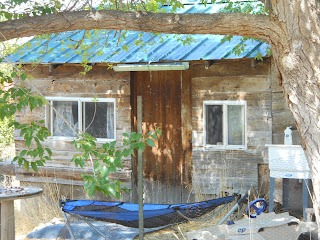Your children will not survive unless you tell something about them--how they were born, how they came to this certain place, how they continued.
I could post pretty much any poem, almost at random, and successfully label it a "sustainable living poem" under my "sustainable living" definition. I use to hate the title of the anthology, Poetry Like Bread, because I felt it overvalued the role of the poet in the world and undervalued the suffering of the poor. So, I've been slow to admit this, but poetry is like bread because it sustains the human spirit of any given culture. Individuals may need food more than poems, but societies need literature to sustain values and identity.
Almost all poems in one way or another are about sustaining the human spirit. In this way, I think the only way to write a poem that is not about sustainable living is to set out purposefully to write a sustainable living poem. A good poem, like a good garden combines the cultivated and the natural--where some thoughts are planted, but wild ones move in, and you realize that even though you didn't plant them, they are beautiful, so you keep them. You trim some images, cut some sounds back--let some be--but you work with the will of the individual impressions and modify them into an organic whole rather than design a poem out of your own will.
In looking over some old poems of mine for a "sustainable living" poem, an odd, but obvious choice came to me: "Grounded"--a war poem, an urban poem, a poem centered the mundane task of grading papers. For me the poem is the perfect "sustainable living poem" simply because it refuses any easy, airy spiritual out. Sometimes sustainability is the search itself--the singing the song, the planting the seed, regardless of whether fruit grows or not. Sometimes yearning is all. I think of Kris Kristofferson's "Sunday Morning." For me, that is the ultimate sustainable living poem. "Grounded" pales in comparison, but it too is grounded in the gap between reality and potential. For me sustainability is there, in that fertile crack.
Grounded
In this story,
light glistens off composition shingles
in sparks and dashes
pours through a classroom window
onto a common houseplant
while a piano is rubbed to bone
and a guitar is ground down
to bedrock
on Pearl Jam's "Black" blaring
from computer speakers
while I grade papers
on this Veterans Day morning.
In this story,
there are no bombs,
no blood, no dangling arms,
no white-out
as souls suck out
of corpses left
lying in the streets
jungles, deserts, front lawns
of foreign lands
where children
find trinkets, pull
pins to grenades, open
wallets, pull out
credit cards, gum, smokes, pick
at remains of unrecognizable aunts,
uncles, fathers, sisters, mothers,
always the mothers, the hardest part.
In this story,
there's only papers to grade, Smashing Pumpkins
slowly unwinding on "Shakedown 1979"
No war to win, no war to lose,
only a piano, always a piano,
somewhere down the corridors of
the mind, a long hall
of dark, scuffed wood
and dusty gold radiator heaters,
an apartment door open,
open for sound, like the lid
of a Steinway grand,
only it's an old banged-up upright
in a room of smoky blue
light and the silhouette of a man plays
as if he could light the hearts--
10,000 dead veterans
in 10,000 countries.
But, of course he can't.
He can play. I can grade.
Tom Petty can be ready to fly, always.
But this world ain't got wings.
No, baby, this world
ain't got
wings.



















